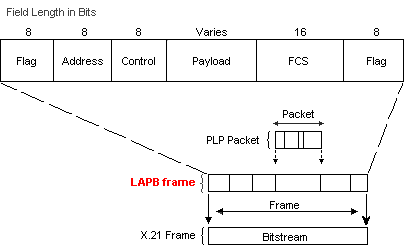Link Access Procedure, Balanced (LAPB) is a reliable synchronous serial protocol used to manage packet framing between DTE and DCE stations. LAPB supports several protocols including X.25, Frame Relay and ATM. LAPB is capable of placing frames in the correct order, as well as checking packets for errors (error detection) and thus releives higher level protocols from having to perform these functions.
FRAME FORMAT
LAPB frames contian a header, encapsulated data, and a trailer. The diagram below shows the format of the of the LAPB frame and its relationship to the Protocol Layer Packet (PLP) and the X.21bis frame. The following descriptions summarize these fields:

| FRAME FIELDS (Frame structure) | ||||||||||||
| Flag 8-bits |
The binary pattern 01111110 is used to mark the beginning of the LAPB frame. This pattern has to be be unique so the transmitter in a LAPB connection uses a bit stuffing technique to make sure that the flag pattern appears only in the flag fields. | |||||||||||
| Address 8-bits |
This field can have two values:
Neither of the two values is actually an address. Because communication is in balanced mode, the communication link is full duplex and either DTE or DCE may initiate or terminate communication. The point of including an address is to indicate whether DTE or DCE is in control of the communication. You will recall that X.25 is a point-to-point communications technology. Its addresses are handled by the X.121 protocol so having an address here is, well, pointless. |
|||||||||||
| Control |
The control field is used to indicate command and response frames and indicates whether the frame is an I-frame, an S-frame, or a U-frame. In addition, this field contains the frame's sequence number and its function (for example, whether receiver-ready or disconnect). Control frames vary in length depending on the frame type. | |||||||||||
| Data |
Contains upper-layer data in the form of an encapsulated PLP packet. | |||||||||||
| FCS |
Handles error checking and ensures the integrity of the transmitted data. | |||||||||||
| Flag 8-bits |
The binary pattern 01111110 is also used to mark the end of the frame. This pattern must be unique, so LAPB uses bit stuffing to make sure that the same pattern doesn't appear anywhere else except in the flags. | |||||||||||
LAPB FRAME TYPES
LAPB uses three types of message frames, I-frames, S-frames and U-frames. Each frame type has a different purpose.
| LAPB FRAME TYPES | |
| Information (I-Frame) |
Informations carry upper layer information and some control information. Information frames pass sequencing, flow control, error detection, and recovery information to the receiver to assist in reconstructing the upper layer data stream. |
| Supervisory (S-Frame) |
Carries control information. Used to request and suspend transmission, report status, and Acknowledge receipt of I-Frames. The following messages are sent using s-frames.
|
| Unnumbered (U-Frame) |
Used for link setup, link disconnection and error reporting. No sequence numbers used. |